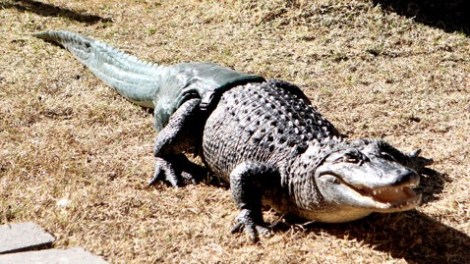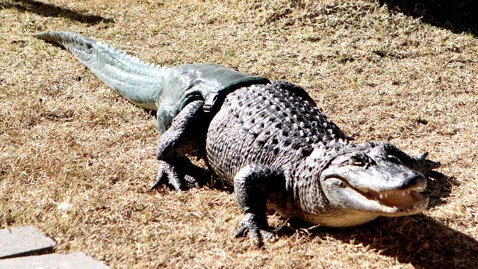
Wendy Cassidy, Phoenix Herpetological Society
Gentlemen, we can rebuild him. We have the technology. We have the capability to build the world’s first bionic alligator. Mr. Stubbs will be that alligator. Better than he was before. Better, stronger, faster. He is … the $6,000 alligator.
Mr. Stubbs, an 11-year-old American alligator about the size of a medium dog, lost his tail eight years ago when a larger alligator bit it off. After painstaking work with trainers he sort of learned how to dog-paddle, but he was still slow and defenseless:
“We put him in deep water and he would roll over and capsize like a boat,” said [Phoenix Herpetological Society president Russ] Johnson. “When competition for food came, all the other alligators would win. He’d be the last to the chow line.”
So orthopedics R&D group the Core Institute partnered with Midwestern University to build Mr. Stubbs a $6,000 artificial tail. After some tweaking, they think they’ve gotten the rubber-and-nylon-straps contraption to a point where Mr. Stubbs will be able to learn to use it like a natural tail, which could quadruple his projected lifespan — a respectable 80 years, instead of 20 years dogged by spinal cord degradation, awkward movement, and struggling for resources.
Of course, he doesn’t know how to swim with it yet:
But go figure, he’s been swimming without a tail for half his life. It’ll take him a little while (his trainer estimates three to six months) to remember how to swim when he has one. And while the new tail is light — only nine pounds — it’s a heck of a lot heavier than his butt has been in years. That makes it easier for Mr. Stubbs to walk in a straight line, since he’s now adequately counterweighted, but it must be kinda weird in the water.
Once he’s re-learned how to move with his substitute tail, it will be time to teach Mr. Stubbs to take full advantage of the thing’s bionic potential. Perhaps it can be wired for cable, or used to store snacks.



